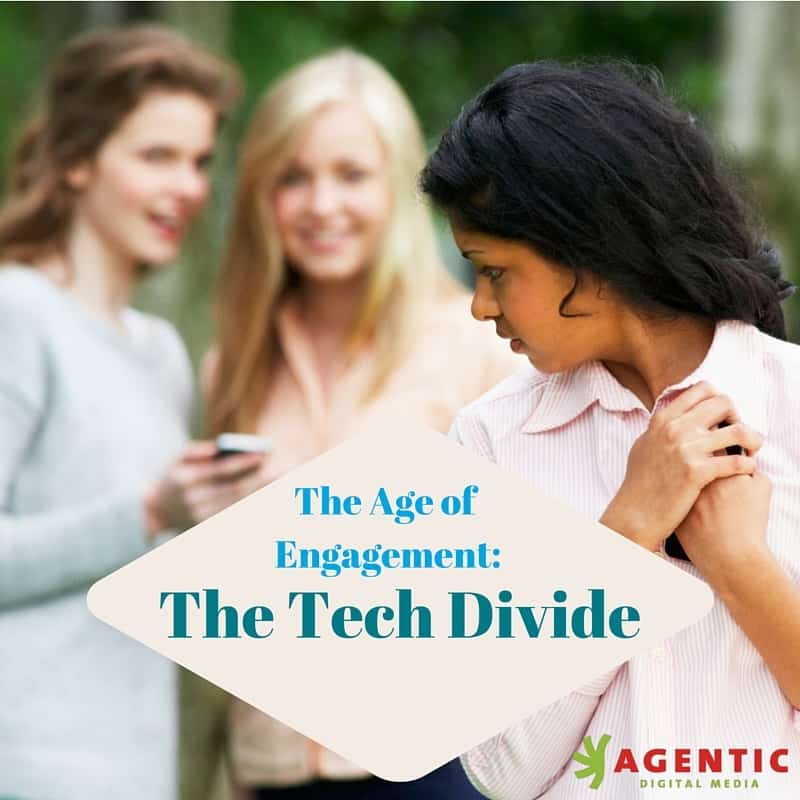The Age of Engagement: The Tech Divide

Jenna* has been in foster care since she was 9 years old. She’ll be turning 18 next month, and as she sits cross-legged, listening to her boyfriend talk about his experience aging out of care, her eyes are glued below the edge of the meeting table. She’s texting. She has been for the duration of the meeting, but she’s not doing a very good job of hiding it. As her boyfriend who sits beside her talks about his difficulty with finding employment after aging out, Jenna’s fingers manoeuver across her keyboard with incredible speed, clicking a steady but off-tempo rhythm. Three quick clicks, one click, three clicks, pause, two fast clicks, one click.
Jenna taps away with a pattern that is unusual to most of us these days. That’s because she is using a flip phone with T9 Word. It means pressing a number key up to three times to get a certain letter of the alphabet. But why wasn’t Jenna silently tapping away on a touch screen iPhone or android device? It’s 2015 and there have already been six generations of iPhones, so why was she using a flip phone with a 10 number key pad?
78% of youth have cell phones, and nearly one half (47%) have smartphones.
The answer is that Jenna and her boyfriend, along with the 15 other aged out youth in the focus group are 63% less likely to own a smartphone than her teenaged peers who have never been in government care. Pew Internet Research data from 2013 show that just over three quarters of youth (78%) have cell phones, and nearly one half (47%) have smartphones. Although there is not definitive data that exists on the number of youth in care who own smartphones versus cell phones like Jenna’s, youth in care face financial, and Internet connectivity barriers that prevent many of them from owning the latest technology.
Pew’s study on youth and mobile devices concluded that almost half of cellphone users have Smartphones, meaning that almost half of the teens surveyed are able to consume and post to social media sites and apps on the go. While there is concern that kids are too connected these days, being able to connect to the web from a smartphone means that teens can access information, connect with mentors, and seek out resources when in need.
Smartphones aren’t just for sharing pictures and sending texts – smartphones can help youth read the news, find out when food banks are open, and call an adult when in crisis. Yet cell phones are also associated with teenage mental health, much more than we might assume. A recent study conducted by the Lincy Institute suggests that positive aspects associated with the use of smartphones can include: relationship building, youth’s increased sense of normalcy, and youth empowerment. So if youth in foster care have been shown to benefit from the use of smartphones, then why are young adults in care so much less likely to own the devices?
A smartphone means that teens can access information, connect with mentors, and seek out resources when in need.
The foremost reason is the financial barrier to owning a smartphone. Meta analysis data collected by Alexandra Samuel demonstrated that the majority of families who foster a child have an average household income of $25,000 – $50,000 (source: Annie E. Casey Foundation Data Center). This number is almost $25,000 less than the average household income of families who do not foster. Lower household incomes among foster families means less disposable funds to spend on the newest gadgets and communications technology for their kids.
Another fascinating finding from Pew’s research is that teens from lower income homes are for more likely to use Facebook than other social media platforms. Pew found that 77% of teens from families earning less than $50,000 annually use Facebook, while only 68% of teens from households earning more say they use the platform. Although young adults like Jenna might also use social media platforms like Twitter or Snapchat, youth like her prefer Facebook.
77% of teens from families earning less than $50,000 annually use Facebook.
So why should organizations that support foster youth care that Jenna is typing with T9 Word on her flip phone? It’s because once we understand the way that Jenna surfs the Internet – and what social media site she favours – we can offer services in ways that are tailored to her. If Jenna mostly uses Facebook, but only has a flip phone, maybe a social service provider shouldn’t create a mobile app that she has to download. As the communications philosopher Marshall McLuhan famously said, “The medium is the message.” It has never been more important to clearly communicate a message, especially when at-risk teens are the ones on the receiving end.
Young adults in foster care consume information and access online spaces in a way that is different than youth who are not in care. By acknowledging this fundamental difference, we can provide better support systems and communicate more effectively with youth in and out of government care.
(*not her real name)
- Author: Marissa Mills
